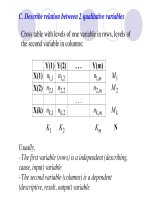Thuyết trinh về đà lạt bằng tiếng anh (đà lạt natural beauty)
Bạn đang xem bản rút gọn của tài liệu. Xem và tải ngay bản đầy đủ của tài liệu tại đây (59.72 KB, 15 trang )
Giới thiệu về cảnh đẹp thiên nhiên đà lạt bằng tiếng anh (Đà Lạt Natural Beauty).
DA LAT CITY
Located on Lam Vien (Lang Blang) Plateau at an altỉtude of nearly 1,500m, Da Lat is the
famous vacation city formed in the early 20th century.
With the temperate climate, Da Lat City owns the poetic beauty thanks to fog in the
morning, colourful flower valleys, green grass hills and pỉne forests surrounding the city.
The city also attracts visitors by the system of rlvers, lakes, springs, waterfalls, and
unique architectural works as pagodas, churches, museums, train station, etc. Especially,
French-style villas on the pines hills make Da Lat like a miniature Paris.
Da Lat is also the homeland of many types of green vegetables, fresh fruit, and hundreds
of unique flowers and ornamental plants. Therefore, Da Lat Flower Festival is the
tourism event drawing numerous domestic and international visitors.
To Da Lat, visitors also have the opportunity to explore the villages of ethnic groups in
the city's suburb, learn about Central Highlands' culture through art, traditional
instrument, gong performances of local people. Da Lat also stores woodblocks of
Nguyen Dynasty recog nized as world documentary heritage by UNESCO.
With the ideal climate and beautiful landscapes, Da Lat City is an attractive destination
for domestic and foreign visitors.
Xuan Huang Lake
Xuan Huong is a poetic lake located in the centre of Da Lat and attracts everybody,
especially the lovers. The ZSha man-made lake has perimeter of some 5km and
crescent-moon shape, close to several tourist spots in Da Lat. The lake is supplied with
water from a small stream that runs north of the lake. On the other side, there is
another small stream that brings water from the lake to the western part of the city.
Both the streams to and from the lake are named Cam Ly. Two kilometres from the lake,
the water runs through a rough bed of large boulders called Cam Ly Waterfall.
The surface of Xuan Huong Lake is as smooth as glass with the reflection of the
surrounding pine trees. Visitors can enjoy a glass of fresh water while fishing and resting
under ancient conifers, pedal boating on the lake, touring the lake by tandem bicycle, or
admiring the lovely architecture of Th uy Ta Pavilion.
Lake of Sighs (Than Tho)
This natural lake situated on top of a hill covered with pine trees, 6km north-east of the
centre of Da Lat, was enlarged by a French-built dam. The lake has a vast and calm
surface. Standing on the edge of the lake, 3 small path running towards the forest can
be seen.
The sounds from the forest resemble the sighing of an invisible man. The lake has been
surrounded by many stories and legends with sorrowful endings in
which the heroine drowns in the lake to keep her true love forever.
Dankia Suoi Vang Lakes
Dankia Suoi Vang lakes is located in Lac Duong District, 20km north of Da Lat. Dankia
and Suoi Vang (also called Ankroet) lakes cover the areas of 2.2km2 and 028ka
respectively, created by flows of Da Dong River and Da Lien Deur Spring. Located at the
foot of the imposing Lang Biang Mountain, Dankia Suoi Vang lakes are a precious gift to
Lam Dong from Mother Nature. This outstanding attraction impresses visitors with
marvelous scenery of vast mountains and pine forests and pure water flows bending
around romantic hills, creating a wonderful painting before the eyes of visitors.
Coming to Dan KiaSuoi Vang area, visitors will be attracted by the natural beauty of Da
Lat Golden Valley, Ankroet Waterfall, Suoi Vang Dam. in addition, the ethnic minorities
of Lat Village inhabiting in the area, have maintained their traditional customs. Thus,
this is also an ideal site for ethnological tourism.
Tuyen Lam Lake
Tuyen Lam Lake with area of 320ha, lies 7km from Da Lat, nearby Datanla Waterfall. The
lake is perfect for activities such as hiking, boating, fishing, etc. The waveless water
surface harmonizing the green of trees and the blue of sky reflecting on the lake in
combination with vast forest of pine trees covering the area makes a picturesque and
romantic landscape.
Da Nhim Lake and Ngoan Muc Pass
Lying on National Road 27 from Phan Rang to Da Lat, Ngoan Muc Pass (or Xong Pha
Pass) is over 20km long, located at the altitude of 1,000m. It has been considered one of
the most beautiful passes in the country and praised in a lot of Vietnamese art works,
music songs and poems. Ngoan Muc Pass offers
spectacular view over a deep slope, pure Da Nhim Lake and Da Nhim hydro. electric
plant.
Located in Don Duong District, 40km east of Da Lat, Da Nhim Lake with area of 9.7km2
was created by a hydroelectric dam built between 1962 and 1964. The water of
hydroelectric plant travels through two nearly 2km pipes down from the mountain. The
dam is 1,460m long, 38m high, 180m wide at the bottom and 6m wide at the peak,
splitting Don Duong Plain into two parts.
Da Nhim Lake and Ngoan Muc Pass make visitors feel small in the grandness of nature
and they are a reminder of the ability of human beings to manipulate nature for their
own benefit.
WATERFALLS
Datanla Waterfall
Datanla Waterfall is situated nearby the Prenn Pass, approximately 5km from Da Lat.
The cascading water falls from a height of 20m to the ground before disappearing
through layers of marble scattered in the small stream. Legend has it that this was
where fairies from heaven gathered together to bathe. Thus, this flat portion of the
stream has been named Suoi Tien (Stream of Fairies).
To contemplate the primitive beauty of Datanla Waterfall, visitors can choose to walk
down the mountain through the forest in about 15 minutes or take several minutes to
slide down a 1,000m gutter which curves around mountain slopes.
There will be some interesting activities that visitors can try as travelling by cable car,
rope climbing at Tu Than Abyss, floating on stream flow, etc.
Prenn Falls
Prenn Falls is located at the foot of Prenn Pass, a 10km long pass on the route between
Da Lat and Ho Chi Minh City. These famous waterfalls are located approximately 100m
from the road. Approaching the falls, there is a subtle change in temperature caused by
the mist of the water falling. The base of the falls is a small valley covered with flowers
and pine trees. The 10m cascading water falls down over the small bridge built across
the little lake.
Dambri Waterfall
0n the way to Ho Chi Minh City, visitors can stop by Bao Loc City, the land of tea, coffee
and mulberry. From Bao Loc, visitors have to turn off the main road and follow the local
road for 18km to arrive at Dambri Waterfall lying in the wild forest. According to
language of Co Ho ethnics, Dambri means ”await". Dambri Waterfall with a height of
60m is one of the highest and most magnificent waterfalls in Viet Nam. Visitors can
choose walkway or elevator to go down the waterfall. They also have chance to visit the
area that houses different animals like monkeys, deers, elephants, bears, tortoises, etc.
or go boating and fishing on Dambri Lake.
Pong Gua (Pongour) Waterfall
This waterfall is the most magnificent and powerful waterfall in the vicinity of Da Lat.
Located in Duc Trong District more than 45km from Da Lat, in the mountains, Pong Gua
Waterfall is 40h high and stretches more than 100rr The waterfalls into a big lake
producin a great noise, whose echo can be heal far away. it is well-known as “Sevei
Floor Waterfall” or Thien Thai (Paradis Waterfall.
Llnh Son Pagoda
Linh Son Pagoda, located on Nguyen Van Troi St., was built in 1936 on a hill of am
overlooking the centre of Da Lat. The pagoda has been managed by a succession of
monks. In the middle altar, there is a 1,250kg bronze statue of Shakyamunl Buddha cast
in 1952. The pagoda ls home to a great bell of 450kg, a drum of 0.75m diameter and a 3storey octagonal tower. In addition, there is a room where preserves Buddhist books.
Besides, visitors can choose something at souvenir shop. The office of the Executive
Committee of the Buddhist Sangha of Lam Dong Province is located here.
Linh Phong Pagoda
Linh Phong Pagoda is located on large and beautiful grounds on Hoang Hoa Tham Road,
Da Lat. The pagoda was built in 1944. On the main altar, there are bronze statues of
Amitabha Buddha, Avalokitesvara Bodhisattva and Mahasthanaprata Bodhisattva.
Built on a small mountaintop, the panorama of the pagoda is as a picture of Elysium
hidden in the mist and the green of the pine forest.
Thien Vuong Co Sat Pagoda
The pagoda is located on a palm tree covered hill at 385 Khe Sanh Road, 5km from the
Da Lat city-centre. It was built in 1958 by the Bonze Superior Tho Da, a Buddhist
dignitary, to follow Chinese Hue
Nghiem Buddhism.
In 1989, Mr. Le Van Can organized the restoration of the Thien Vuong Pagoda, also
called Tau Pagoda. it consists of three yellow buildings. A 3m-high statue of Maitreya
Buddha is placed at the centre of Tu Bi (Merciful) Sanctum. There are also four great
statues of the Four Heavenly Kings which are 2.6m high and made of concrete. There
lies a miracle spinning round table to the left of Tu Bi Sanctum which amazes visitors for
its uncanniness. ln Quang Minh Sanctum
there are three statues of the: Amitabha Buddha, Avalokitosvara Bodhisattva and
Mahasthanaprata Bodhisattva. The statues are 4m high, weigh 1.5 tons each and were
Imported from Hong Kong In 1958 by Some Superior Tho Da. Behind Quang Minh
Sanctum, there places a 10m high statue of Shakyamunl Buddha in seated meditation on
lotus.
Truc Lam Zen Monastery
Truc Lam Zen Monastery is located amidst beautiful natural scenery, by Tuyen Lam Lake,
Ward 3 in Da Lat. The construction of the monastery started on 28 April 1993, and was
later Inaugurated on 8February 1994.
This outstanding architectural ensemble covers an area of 24ha. in the 192m2 main
sanctum, there is 2m-high statue of Shakyamuni Buddha with the right hand holding a
lotus flower branch; statue ofManjusri Bodhisattva riding on a lion; statue of
Visvabhadhra Bodhisattva riding on a slx-tusk white elephant. To the right of the main
sanctum is a bell pavilion which houses a 1.1 ton great bell carved with meaningful
Buddhist teachings. Visitors will also be amazed by the beautiful garden in the
Monastery with abundance of rare flowers.
Da Lat Cathedral
The cathedral, which is located on Tran Phu Road, near the Novotel Da Lat Hotel, was
built between 1931 and 1942. This cathedral was used by the French and other
Europeans who used to live in Da Lat or to spend holiday there. The cathedrai looks like
a European cathedral from the Middle Ages with its many stained glass windows and
47m bell-tower.
Masses are held from Mondays to Sat~ urdays at 5.303m and 5.15pm, and Sundays at
5.303m, 7.00am, and 4.00pm.
OTHERS
Da Lat Flower Park
Da Lat Flower Park is famous for its diverse species of flowers. Covering an area of
7,000m’, the park is considered a natural museum that houses a big collection of native
and exotic flowers.
Coming to the park, visitors can get lost In the splendid beauty of a flower paradise of at
least 300 different kinds of flowers, hundreds of which are in blossom all year round.
Some of which could be named as mimosa, rose, orchid, daisy, health-bell, gerbera,
cactus, etc.
First built in 1966, the flower park was then fallow. Since 1985, the park was rebuilt and
beautiful flowers have been planted in service of visitors to the park.
The park is located at 2 Phu Dong Thien Vuong St., which leads from Xuan Huong Lake to
Da Lat University.
Opening time: 7.30am 5.00pm daily
Fare: adults: VND 30,000/person; children: VND 15,000/person
Valley of Love
Valley of Love is surrounded by pine tree covered hills, approximately 5km north of the
centre of Da Lat, on Phu Dong Thien Vuong Road. During King 830 Dai's reign, the valley
was called Hoa Binh (Peace), but the name was later changed to the Valley of Love. in
1972, Da Thien Lake was added to the valley. As a result of this enhancement, the valley
has become even more poetic and seductive.
One of the most beautiful attractions at Valley of Love ls Vong Canh Hill the best place
to contemplate mimosa blossoms. Coming here, visitors can also find Tieu Son Lam
flower garden with big trees in amazing forms. A picturesque scenery of Valley of Love
reveals before the eyes of visitors standing at the peak of Vong Canh Hill.
Covering an area of 140ha, the Valley is considered an ideal destination for camping,
teambuildlng activities, or horse riding, travelling byjeep and old train, etc.
Lang Biang Mount and Bidoup Nui Ba National Park
Covering an area of more than 70,000ha in Lac Duong and Dam Rong districts, about
30km to the north of Da Lat City, Bidoup Nui Ba National Park is estimated by the
scientists as one of 221 endemic bird centres of the world and one of 4 biodiversity
centres of Viet Nam.
The national park owns diversified ecosystem with nearly 750 species of fauna, of which
many ones are listed in lUCN’s Red Book as black-shanked douc langur, gayal, Asian
golden cat, Tibetan bear, tiger, dhole, etc, and more than 1,900 species of flora with
many valuable and rare ones such as krempf's pine, gastrochilus calceolaris, calocedrus
macrolepis, Viet Nam hinoki, etc. In particular, Bidoup Nui Ba National Park is also
considered as the kingdom of orchids with more than 250 species.
Coming to Bidoup Nui Ba National Park, visitors can participate in outdoor activities,
hiking, or learn about the culture of indigenous ethnic groups through Hon Giao Giang
Ly route (1.8km) the paradise for those who love to learn about birds and mushrooms;
Thien Thai route (3.5km) discovering Thien Thai Waterfall, threeleaf pine hills and coffee
farms; 17km route to 2,287m Bidoup Peak the highest peak in Lang Biang Plateau; Da
Blah route learning about the culture of Co Ho ethnic people. Especially, visitors do not
miss to conquer 2,167m Lang Biang Mount with many attractive sites such as Tram Nam
(One hundred years) Valley, Mimosa Ground, Dankia Hill, Cu Lan Village, etc. Cu Lan
Village lying in the foot of Lang Biang Mount owns the pristine beauty with traditional
stilt-houses of Co Ho people nestled in the charming natural space of mountain and
forest. Visiting Cu Lan Village, visitors have the opportunity to take part in outdoor
activities as paddling raft, taking terrain car to explore the village and primary forest,
flying kite, riding horse, hunting wild chicken, catching fish, etc. or being immersed in
gong dancing with local people, etc.
Lang Biang Biosphere Reserve with the core zone of Bidoup Nui Ba National Park has
been recognized as World Biosphere Reserve by UNESCO since 2015.
Da Lat Market
Da Lat Market is one of the most colourful and lively markets in the country. Hundreds
of stalls display a wide array of flowers, fruits and vegetables from the tropical and
temperate zones. From here come most of the flowers and fresh vegetables that are
sent to Ho Chi Minh City and other provinces. The market, famous for local specialties as
jams, teas, strawberries, wines, flowers, fresh vegetables and fruits, woollen clothes,
etc., is not only a shopping hub but an interesting tourist attraction in the city of Da Lat.
Da Lat Market is open from 7.00am to 7.00pm everyday.
Visitors can also join the night market (in front of the gate of Da Lat Market) to
experience activities at night and go shopping also.
Palaces
Da Lat has three magnificent, large palaces, which are simply referred to as Palace 1,
Palace 2, and Palace 3. Located on the top of hills in beautiful natural surroundings, the
palaces were built according to French design. They are accessible by long flights of brick
steps, which are completely covered by a broad canopy of pine trees.
Palaces 1 and 2 were owned by highranking officials during the French colonial period.
Palace 2 is a dignified building of modern design, built in 1933. Consisting of 25 rooms,
the palace is now used as a guesthouse and for official re~ ceptions. Palace 2 is located
up the hill from the intersection of Tran Hung D30 and Khoi Nghia Bac Son streets, 2km
east of the centre of Da Lat.
Palace 3 was owned by the last king of the Nguyen Dynasty, Bao Dai. It is located on Le
Hong Phong Road, 500m southeast of Pasteur Institute and 2km southwest of the
centre of Da Lat.
The palace has 2 floors:
The ground floor was used for organizing meetings, banquets or reception ign guests
and government officials affore ng Trieu Cuong Tho (Domain de OfHoiaironne in
French). Entering the la inde main door, visitors reach the 2:23: hall and then reception
room, King Bao Dai’s office, library, meeting room, working rooms and room fOr
entertainment.
-The second floor was used as the private space of the royal family with bed rooms of
King Bao Dai and his wife, Queen Nam Phuong, and their daughters and sons. Vong
Nguyet Pavilion outside of the bedroom was a lovely place for watching the moon. The
bedroom of Prince Bao Long was painted yellow and all decorations have the same
colour since he was selected to ascend the throne.
The palaces are open daily from 7am to 5.30pm.
Lam Dong Museum
Lam Dong Museum is located at 4 Hung Vuong Road, on the top of a hill, about 3km
from central Da Lat City. The museum holds over 15,000 objects on display, including
many unique and precious collections. The museum is the gate way to Lam Dong’s
culture and history with following main contents: Nature of Lam Dong; History of Da Lat;
-Archaeological findings in Lam Dong; Typical cultural characteristics of indigenous
ethnics (Ma, Co Ho, Chu Ru); Lam Dong in two resistance wars of the nation against
foreign invaders; Lam Dong people in the development and defense of the nation.
Coming to Lam Dong Museum, visitors can enjoy the charming and romantic space of Da
Lat and also participate in folk games as con throwing, swinging, making ceramic
products, Dong Ho folk paintings, etc.
Opening time: 7.303m 11.30am and 1.30pm 4.30pm daily.
Fare: VND 10,000/person. National Archives Centre No. 4
The National Archives Centre No.4 under the State Records and Archives Department of
Viet Nam (formerly Tran Le Xuan Private Residence) located at 2 Yet Kieu St., Da Lat City
is the place where stores and preserves the originals of the Nguyen Dynasty
woodblocks, and displays reproductions of these records for visiting and researching.
This is regarded as a valuable library that has very rich contents with varied topics:
history, geography, military affairs, legislation, prose and verse, religion ideal
philosophy, language literature, sociopolitics, culture education. Woodblocks are
sources of reliable history to help to study, compare, review relevant history materials
to serve better for researching different times of Vietnamese history.
Such woodblocks carved with official literary and historical works of feudal dynasties are
very rare in the world. In July 2009, the Woodblocks of Nguyen Dynasty have been
recognized as a World Documentary Heritage by UNESCO. They became the first entry
of Viet Nam in the list of UNESCO's Memory of the World Programme.
Hang Nga Villa (Crazy House)
Located in 3 Huynh Thuc Khang St., Hang Nga Villa is popularly known as Crazy House. It
is an unconventional building designed and constructed by architect Dang Viet Nga. The
house has 10 rooms, each one is named after an animal or plant as tiger room, eagle
room, ant room, kangaroo room, etc. All rooms were built into an organiCalooking
structure that resembles









